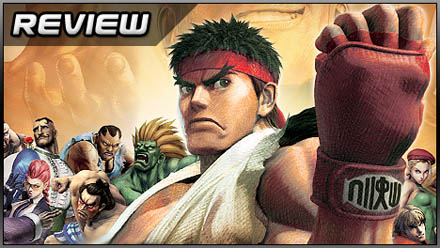
Over the course of the Street Fighter series’ 24 year history much has been made of Capcom’s obsession with “Editions”. Yet even amongst the company of Champions, Turbos and EX Plus Alphas, 3D Edition stands out as perhaps the least essential of updates.
Hardware (particularly Nintendo’s) can serve as the inspirational catalyst for developers to breath new life into tired franchises (see the DS Zelda games or even Capcom’s very own Okamiden) but this process appears to have been reverse engineered for 3DE. Rather than the 3DS sparking an idea in Yoshinori Ono’s creative loins, it seems he’s been forced to shoehorn the hardware’s unique features into Street Fighter’s streamlined arcade roots with some curious, if not wholly amazing results.
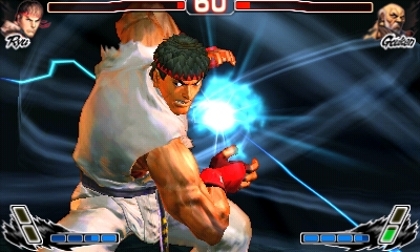
The hit in detail is scarcely noticeable on the small screen. It's worlds away from the cheap cut-outs of the iPhone version.
A portable build of the enduringly robust Super Street Fighter IV (see our resoundingly positive review of that game here), Capcom are to be applauded on their conversion of the core game. The existing bold and vibrant art direction along with dynamic zooms and pans that accompany introductions and ultra moves translate naturally the 3D display with no modification required, and even when locked into the standard side-on gameplay, the distance between HUD, characters and background creates a somewhat bizarre but unique visual re-skin. Player-controlled puppets leap around stages like pugilistic Punch and Judy’s as the 3DS works to create a striking visual treat.
Sure, character models are obviously less detailed, spot effects are noticeably less impressive and the static backgrounds take the brunt of the visual compromise, but the frame rate remains smooth and the overall look of the game does a superb job of emulating its console kin. In fact surprisingly little has been lost in the leap from DVD to 3DS card, with only Team Battle, Endless Battle, Tournament Mode, the Replay Channel and the Japanese/English voice options failing to make the cut. In recompense, 3DS owners get the every single costume pack released to date (except for the most recently released Ultra pack) and access to all colour variants right out of the gate.
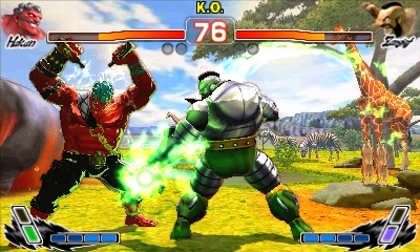
The Solar Eclipse stage suffers from the lack of animation more notably than the others. Meerkat and flamingo fans will be sorely disappointed.
So far, so familiar, but what’s new exclusively for 3DS players? This is where things get gimmicky. The most obvious addition to arcade mode is the Dynamic View. The standard side-on view is tilted 45 degrees to somewhere just over your character’s shoulder giving you a peculiar view of the action that looks neat for about two rounds to demonstrate to crowds (not that the 3DS is the most spectator-friendly handheld), but screws with your ability to judge distances so drastically it renders the game nigh-on unplayable. Considering how experimental this view is, it might have been a good idea to include an option to switch in-game, a la Tekken.
Next up on the list of things you didn’t expect to see yourself to be doing in a Street Fighter game we have the Figure Collecting mode. Now collecting 3D renders of in-game assets is nothing new to gaming (and one that I feel we’re going to see a lot more of on the 3DS), but the lengths Capcom have gone to in order to flesh out the experience is bewildering. Up to 500 bottle top renders of fighters in various dynamic poses can be collected by spending Figure Points on a roulette wheel. Figure Points can be earned through gameplay, or, in an interesting use of the hardware, swapped for the 3DS’s Play Coins earned through strolling about with StreetPass turned on. Figure obsessives can then assemble a team of figures to compete in stat-based battles against other people’s teams via StreePass.
These battles are fought in the privacy of your own pocket, whether your 3DS or 3DE is even running. Once you flip your machine back on you can view the results of the battle and even choose to link up with said mysterious stranger and duke it out more traditionally online. As a method of making new friends, it’s at least innovative, though in practical terms it remains to be seen how the concept will flourish outside of a densely packed city like Tokyo.
If hands-off RPG battles don’t do it for you, 3DE does cater to pretty much every networking feature the hardware supports from the one-card Ryu-only download play (surely Ken-only would’ve covered more of the player base), local wireless versus and internet play. Internet play is surprisingly consistent, with lag-free, instant matches as standard.
Controls are something that are largely out of Capcom’s hands, and with only a tiny d-pad, four face buttons and less-than-ideal shoulder buttons, handling a technical fighting game like Street Fighter was always going to be an uphill struggle. Anybody managing to nail Viper or Gen’s 24th trial on this set-up deserves a kiss from Yoshinori Ono himself. In an attempt to address this difficulty 3DE introduces four touch screen command shortcuts.
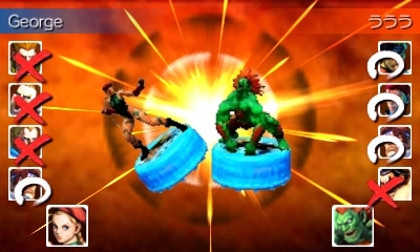
Battle your figures against unknown rivals in bouts you didn't even know took place. This is hands-off handheld gaming.
On Lite mode these can be assigned to normal, specials, supers or ultras, while Pro mode allows only button-binding for normal attacks. A word of warning however – always select Pro control scheme and fight players using the same scheme if you go online. I’m all for lowering the execution barrier to bring new players in, but a Guile that can walk forwards and Sonic Boom/Flash kick with no regard for charge times (even fast enough to link them into each other!) is a serious abuse of the rule sheet and has no place in a fair game.
In jumping into the ring early, Capcom are among the first developers to cut their teeth on Nintendo’s new hardware, and their willingness to experiment with the machine, while not radically improving the experience, at least shows that they treated it with more thought than your average launch shovel-ware. Competitive Street Fighter fanatics will find little in the gimmicks on offer to up their game, but with Nintendo’s fondness for expanding audiences, Street Fighter may just have found itself some new fans.


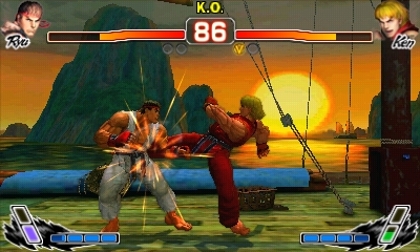
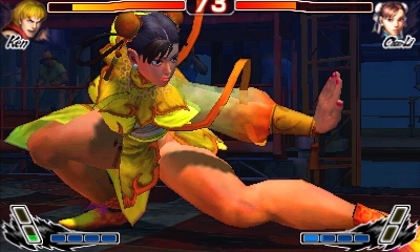




 Satoru Iwata Video Interview - the late Nintendo president spoke with Kikizo in 2004 as 'Nintendo Revolution' loomed.
Satoru Iwata Video Interview - the late Nintendo president spoke with Kikizo in 2004 as 'Nintendo Revolution' loomed. Kaz Hirai Video Interview - the first of Kikizo's interviews with the man who went on to become global head of Sony.
Kaz Hirai Video Interview - the first of Kikizo's interviews with the man who went on to become global head of Sony. Ed Fries Video Interview - one of Xbox's founders discusses an epic journey from Excel to Xbox.
Ed Fries Video Interview - one of Xbox's founders discusses an epic journey from Excel to Xbox. Yu Suzuki, the Kikizo Interview - we spend time with one of gaming's most revered creators.
Yu Suzuki, the Kikizo Interview - we spend time with one of gaming's most revered creators. Tetris - The Making of an Icon: Alexey Pajitnov and Henk Rogers reveal the fascinating story behind Tetris
Tetris - The Making of an Icon: Alexey Pajitnov and Henk Rogers reveal the fascinating story behind Tetris Rare founders, Chris and Tim Stamper - their only interview? Genuinely 'rare' sit down with founders of the legendary studio.
Rare founders, Chris and Tim Stamper - their only interview? Genuinely 'rare' sit down with founders of the legendary studio. The History of First-Person Shooters - a retrospective, from Maze War to Modern Warfare
The History of First-Person Shooters - a retrospective, from Maze War to Modern Warfare